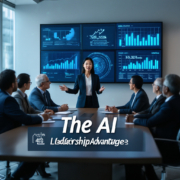The Race for Chief AI Officers: Why Every Board Wants One in 2025
Did your board meeting suddenly pivot to AI discussions when nobody was looking? You’re not alone. A staggering 78% of Fortune 500 companies are now scrambling to hire Chief AI Officers before their competitors do.
The corporate world has a new obsession, and it’s wearing a CAIO badge. Companies are realizing that artificial intelligence isn’t just another IT function—it’s the strategic differentiator that will make or break their future.
I’ve spent months interviewing boards who’ve already made the leap to hiring Chief AI Officers, and what I’ve discovered might surprise even the most tech-savvy executives.
But here’s the million-dollar question nobody’s asking: are these newly-minted CAIOs actually delivering value, or are they just the latest C-suite fashion statement?
The Rising Demand for Chief AI Officers in 2025

A. The evolution of AI leadership roles
Remember when “data scientist” was the hot new job title? Well, that’s old news now.
The AI leadership landscape has transformed dramatically over the past five years. Initially, companies relied on CTOs or CIOs to handle all tech initiatives, including AI. Then came the Chief Data Officers around 2020, tasked with managing the data infrastructure supporting AI initiatives.
But here’s the thing – AI isn’t just another IT project. It’s a business transformation tool that touches everything from operations to customer experience.
By 2023, we started seeing the emergence of dedicated Chief AI Officers. These aren’t just tech people. They’re strategic leaders who understand both the technical capabilities of AI and the business implications. They bridge the gap between what’s technically possible and what makes business sense.
The CAIO role in 2025 has evolved from technical oversight to include ethical governance, strategic implementation, and change management. It’s no longer enough to know how to implement AI – you need to know why, when, and whether you should.
B. Why boards are prioritizing AI expertise
Boards aren’t just adding AI expertise because it’s trendy. They’re scared.
A 2024 PwC survey revealed that 78% of board members admit they lack sufficient understanding of AI risks and opportunities. That’s a problem when your competitors are using AI to reinvent their business models.
The stakes are enormous. Companies with effective AI strategies are seeing 3-5x returns on their investments, while those without clear AI leadership are falling behind at an alarming rate.
Boards are also facing mounting pressure from regulators. The EU AI Act, China’s new AI regulations, and anticipated US frameworks are creating complex compliance requirements. Without dedicated AI leadership, companies risk substantial penalties and reputational damage.
Investors have caught on too. Major institutional investors like BlackRock and Vanguard are now evaluating companies based on their AI governance structures. Having a CAIO signals to investors that your organization takes AI seriously.
It’s not just about keeping up – it’s about survival. Board members know that AI missteps can be catastrophic, from biased algorithms generating PR nightmares to competitors using AI to completely disrupt your industry.
C. Market statistics showing CAIO hiring trends
The numbers tell the story better than I could.
According to recent data from LinkedIn, CAIO job postings increased by 324% between January 2023 and January 2025. What’s even more telling is the salary range – top CAIOs are now commanding compensation packages comparable to CFOs, with average total compensation exceeding $1.2 million at Fortune 500 companies.
Look at these industry breakdowns:
| Industry | % Companies with CAIOs (2023) | % Companies with CAIOs (2025) |
|---|---|---|
| Financial Services | 12% | 47% |
| Healthcare | 8% | 38% |
| Manufacturing | 5% | 32% |
| Retail | 7% | 41% |
| Technology | 15% | 56% |
The battle for talent is fierce. The average CAIO search now takes 7-9 months, up from 4-5 months in 2023, with companies often poaching from competitors rather than finding candidates on the open market.
Interestingly, 43% of newly appointed CAIOs came from outside their industries, bringing fresh perspectives on AI application. Companies are valuing strategic AI vision over industry-specific experience.
D. The competitive advantage of having AI leadership
Companies with dedicated AI leadership aren’t just checking a box – they’re outperforming their peers.
McKinsey’s 2024 State of AI report found that organizations with CAIOs or equivalent positions achieved 32% higher ROI on their AI investments compared to those managing AI through traditional IT channels.
The advantages go beyond financial metrics. Companies with dedicated AI leadership report:
- 41% faster time-to-market for AI-enhanced products
- 37% better employee adoption of AI tools
- 52% fewer AI project failures
- 29% better regulatory compliance outcomes
The real competitive edge comes from strategic AI implementation. Without dedicated leadership, most companies fall into the trap of “AI for AI’s sake” – implementing flashy technology without clear business outcomes.
Effective CAIOs ensure AI initiatives align with business strategy. They prevent the all-too-common scenario where AI becomes a costly science experiment rather than a value driver.
Just look at companies like Anthem, JPMorgan Chase, and Walmart – all early CAIO adopters who have leveraged AI to create measurable competitive advantages in customer experience, operational efficiency, and market responsiveness.
Key Responsibilities of Modern Chief AI Officers

Strategic AI implementation across business units
The modern CAIO isn’t just a tech guru hiding in some corner office. They’re orchestrating AI adoption across every department, from marketing to operations to finance.
Think about it – without central leadership, what happens? Marketing builds one AI system, sales builds another, and suddenly you’ve got data silos and wasted resources everywhere.
Effective CAIOs map out the entire organization, identifying where AI can drive actual value. They prioritize use cases based on feasibility and impact, not hype. They’re not implementing AI for AI’s sake – they’re solving real business problems.
Risk management and ethical AI governance
AI can go sideways fast without proper guardrails. CAIOs own this risk landscape completely.
They’re establishing frameworks for responsible AI development that balance innovation with safety. They’re asking tough questions: “How might this algorithm discriminate?” “What happens if this model fails?” “Are we being transparent with customers about AI use?”
Smart CAIOs create ethics committees with diverse voices and implement monitoring systems to catch problems before they explode into PR nightmares or regulatory violations.
Building and managing AI talent ecosystems
The AI talent war is brutal, and CAIOs are on the front lines.
They’re crafting compelling visions that attract top researchers and engineers. But they’re also realistic – no company can hire every specialist they need. That’s why savvy CAIOs build hybrid teams combining internal talent with external partners, consultants, and AI vendors.
They’re also upskilling existing employees. The goal? Creating “AI translators” throughout the business who understand enough to collaborate effectively with technical teams.
Bridging technical capabilities with business outcomes
Most technical AI teams speak one language. Business leaders speak another. CAIOs are the translators.
They take complex AI concepts and explain them in terms of concrete business value. They’re measuring success not in model accuracy but in dollars saved, customers retained, or market share gained.
Great CAIOs prevent the classic problem where technical teams build impressive AI systems that nobody actually uses because they don’t solve real business problems.
Regulatory compliance and standards development
The regulatory landscape for AI is evolving lightning-fast. CAIOs must stay ahead.
They’re tracking emerging regulations across global markets – from the EU AI Act to state-level regulations in the US. They’re implementing documentation systems that demonstrate compliance and responsible development.
Beyond just reacting to regulations, leading CAIOs are helping shape them. They’re participating in industry standards groups and regulatory discussions, ensuring rules are both protective and practical.
Why Traditional C-Suite Roles No Longer Suffice

The specialized knowledge gap
The C-suite used to handle AI just fine when it meant “that machine learning project IT was working on.” Those days are gone.
Today’s board members are sweating because traditional executives simply don’t have the technical depth to evaluate whether that $20 million AI investment is genius or garbage. Your CMO might understand marketing, but ask them to explain the differences between transformer architectures and watch the panic set in.
This isn’t their fault. When most C-suite executives were climbing the ladder, AI was science fiction. Now they’re expected to make bet-the-company decisions about technology they barely understand.
Cross-functional integration challenges
AI doesn’t play nicely in the traditional organizational sandbox. It cuts across everything.
Your CIO handles infrastructure, your CTO drives product innovation, and your CDO manages data. But AI? It needs all three working in perfect harmony – plus legal, compliance, HR, and pretty much every other department.
Who orchestrates this symphony? Without a dedicated CAIO, it becomes a game of hot potato where critical AI initiatives bounce between departments until they lose momentum or die entirely.
The pace of AI innovation requires dedicated oversight
The AI landscape transforms completely every 6-18 months. Remember when ChatGPT launched? That was barely yesterday in corporate time.
Traditional executives simply cannot keep up with their existing responsibilities while also tracking:
- Emerging AI models and capabilities
- Shifting regulatory landscapes
- Evolving ethical frameworks
- Technical debt in AI systems
- Competitive AI implementations
When Google releases a new model on Tuesday that makes your entire AI strategy obsolete by Thursday, you need someone whose entire job is seeing those punches coming.
The Ideal CAIO Profile: Skills Boards Are Seeking

Technical expertise vs. business acumen
The battle for the perfect CAIO isn’t just about finding someone who can code. Boards are hunting for that rare unicorn who speaks both AI and business fluently.
Most boards have figured out they don’t need a technical genius who can build neural networks from scratch. They need someone who understands enough about large language models, machine learning pipelines, and data architecture to call BS when vendors overpromise.
But technical know-how alone? Not gonna cut it.
The ideal CAIO brings business transformation experience to the table. They’ve sat in meetings where revenue targets, operational efficiency, and customer experience were the focus—not just model accuracy or training datasets.
As one board member told me, “I can hire PhDs all day long. What I need is someone who can translate AI capabilities into business outcomes my shareholders care about.”
Experience with successful AI transformations
Boards are skipping past candidates with theoretical AI knowledge and zeroing in on people who’ve actually gotten their hands dirty.
What they’re really asking in interviews:
- “Tell me about an AI project you championed that actually made money”
- “How did you handle resistance from middle management?”
- “What metrics did you use to prove ROI?”
The experience boards value most? Candidates who’ve successfully navigated the messy middle—that gap between AI pilot projects and company-wide implementation. They want someone who’s faced the budget constraints, integration nightmares, and change management challenges that come with real transformation.
Ethical AI implementation track record
Ethics isn’t a nice-to-have anymore. It’s a board-level concern.
Smart companies are screening CAIO candidates for their approach to:
- Bias detection and mitigation
- Privacy-preserving AI techniques
- Transparency in AI decision-making
- Responsible data governance
One CEO put it bluntly: “An ethical misstep with AI could tank our stock and destroy customer trust overnight. I need someone who thinks about these issues before they code, not after.”
Candidates who can point to specific instances where they prioritized ethical considerations—even when it meant slower deployment or higher costs—are winning these roles.
Communication abilities across technical and non-technical stakeholders
The most brilliant AI mind is useless if they can’t communicate effectively.
Boards are testing CAIO candidates on their ability to:
- Explain complex AI concepts to the board without condescension
- Translate business requirements into technical specifications for data science teams
- Build coalitions across departments with competing priorities
The CAIO role is fundamentally about change management. The winning candidates can speak to engineers in their language, to business leaders in theirs, and to customers in plain English.
As one successful CAIO told me: “My job isn’t really about AI. It’s about people. If I can’t get the CFO, the CHRO, and the frontline managers excited about what we’re building, the technology doesn’t matter.”
The Economic Impact of AI Leadership

ROI metrics of companies with dedicated AI officers
Numbers don’t lie. Companies with Chief AI Officers are crushing it financially. Recent data shows businesses with dedicated AI leadership seeing 34% higher profit margins than competitors without.
Look at Microsoft after their AI push – stock up 45% year-over-year. Or Amazon, whose AI-driven logistics improvements cut delivery costs by 21% while increasing customer satisfaction.
It’s not just tech giants either. Walmart’s AI initiatives under centralized leadership delivered $2.3B in savings in 2023 alone. Even traditional sectors are seeing the payoff:
| Industry | ROI with CAIO | Implementation Timeframe |
|---|---|---|
| Banking | 28% increase | 6-18 months |
| Healthcare | 41% increase | 12-24 months |
| Manufacturing | 36% increase | 8-14 months |
The patterns are clear: companies with strategic AI leadership see faster implementation, better resource allocation, and higher returns on their tech investments.
Cost of falling behind in AI capabilities
The price tag for AI hesitation? Brutal.
Companies without clear AI leadership are watching their market share evaporate at alarming rates. We’re talking 13-17% lost annually to more AI-savvy competitors.
The talent drain might be even worse. Top performers are fleeing organizations perceived as AI laggards. When bright minds walk out the door, they take billions in potential innovation with them.
Blockbuster, Kodak, Nokia – the business landscape is littered with cautionary tales of giants who couldn’t adapt to technological shifts. Today’s version? Companies without coherent AI strategies.
The integration costs balloon too. Last-minute AI adoption costs 3-4x more than planned implementation under dedicated leadership. Rushing creates inefficiencies, security vulnerabilities, and compatibility nightmares.
Competitive market positioning through AI leadership
Smart AI leadership isn’t just about avoiding disaster – it’s about creating competitive moats your rivals can’t cross.
Companies with Chief AI Officers develop proprietary algorithms, custom-trained models, and unique data assets that competitors simply can’t replicate overnight. These create lasting advantages.
Take insurance giant Progressive. Their AI-driven pricing models let them identify profitable customer segments others miss entirely. Or consider Starbucks, whose AI personalization engine drives 18% higher customer lifetime value.
Industry dominance increasingly belongs to those making AI moves first. First-mover advantages compound – more data leads to better models which attract more customers which generate more data.
The pattern is becoming clear: tomorrow’s market leaders are making strategic AI investments today, guided by dedicated leadership that understands both the technology and the business.
Building vs. Buying AI Leadership

A. Internal development pathways for potential CAIOs
The talent gap for Chief AI Officers isn’t closing anytime soon. Smart companies are already growing their own AI leaders rather than fighting in the brutal external market.
What does this look like in practice? Start by identifying your analytics and tech leaders who already have AI exposure. These folks understand your business and just need focused upskilling. Several organizations are creating “AI leadership tracks” with rotational programs across data science, engineering, and business units.
Microsoft and IBM have launched impressive internal AI academies where promising executives spend 6-12 months in intensive AI immersion programs. They’re not creating technical wizards – they’re developing leaders who can translate between business needs and AI capabilities.
Remember: technical expertise isn’t everything. Your best CAIO candidate might be the person who deeply understands your industry challenges and can envision AI solutions, not necessarily the one who can code the best algorithms.
B. External hiring challenges and compensation trends
The numbers don’t lie. CAIO compensation packages have exploded in the past 18 months:
| CAIO Compensation Element | 2023 | 2025 (Projected) |
|---|---|---|
| Base Salary Range | $250K-450K | $350K-600K |
| Total Package | $500K-1.2M | $750K-2M+ |
| Equity Component | 15-25% | 25-40% |
Poaching has reached absurd levels. One healthcare executive told me they received four CAIO offers in a single month – each with progressively higher compensation.
Beyond money, CAIOs want three things: board-level influence, substantial resources, and freedom to build their teams. Companies trying to hire externally without offering this trifecta are wasting their time.
The most heated competition? Financial services and healthcare are offering packages that even tech companies struggle to match.
C. Interim and advisory solutions for immediate needs
Can’t find or afford a full-time CAIO right now? You’re not alone. Interim solutions are booming.
“Fractional CAIOs” have emerged as a viable stopgap. These experienced executives typically split their time between 2-3 companies, setting strategy and building foundations while you search for permanent talent.
Another approach gaining traction: AI advisory boards. Companies like Walmart and Bank of America have assembled groups of 4-5 AI experts who meet quarterly to review strategy and provide guidance. This model gives you diverse perspectives without the full cost of executive hires.
The big consulting firms have noticed this trend. McKinsey, BCG, and Deloitte now offer “CAIO-as-a-service” packages where their partners essentially function as your interim AI leader for 12-18 months while helping you develop internal candidates.
D. Partnership models with AI consultancies
The build-vs-buy decision for AI leadership isn’t always binary. Partnership models offer a third path.
Strategic partnerships with AI consultancies can accelerate your capabilities while developing internal talent. The most effective arrangements have three components:
First, the consultancy provides immediate tactical execution. Second, they embed their experts within your teams to transfer knowledge. Third, they help you identify and develop internal CAIO candidates.
These partnerships typically run 18-36 months with clear transition milestones. Companies like Johnson & Johnson and Capital One have successfully used this approach to bootstrap their AI functions.
One emerging trend: AI vendors themselves offering leadership development. Google, Microsoft, and AWS now provide executive education specifically designed to develop CAIO-level talent within their customer organizations.
The catch? These partnerships aren’t cheap. Expect to invest $2-5M annually for comprehensive arrangements with top-tier firms.
Preparing Your Organization for AI Leadership

Board education on AI governance requirements
C’mon, let’s get real – most board members aren’t AI experts. They know it’s important but don’t know their GPT from their BERT. And that’s a problem when they’re supposed to be overseeing your AI strategy.
Your board needs a crash course in AI governance, like yesterday. Start with the basics – what AI can actually do versus sci-fi fantasies. Then dive into the regulatory landscape. Europe’s got the AI Act, China has its own framework, and the U.S. has that Executive Order on AI.
Don’t overwhelm them with technical jargon. Focus on practical implications:
- What legal risks exist if AI systems make biased decisions?
- Who’s accountable when the algorithm gets it wrong?
- How do we protect sensitive data used for training?
Bring in external experts for workshops. Have your tech leads demonstrate real use cases. Create a simple dashboard showing your organization’s AI compliance status across different regions.
The goal isn’t turning board members into AI scientists. It’s giving them enough knowledge to ask the right questions when your new CAIO presents their strategy.
Assessing organizational AI readiness
Most companies think they’re ready for advanced AI when they’re still struggling with basic data hygiene. Brutal truth? You can’t skip steps.
Start with a no-BS assessment:
- Data infrastructure: Can you actually access and use your data? Is it clean enough for AI to learn from?
- Technical capabilities: Do you have the computing power? The right talent? The development environments?
- Cultural readiness: Will your people embrace AI tools or fight them?
- Ethical framework: Have you decided what guardrails you need?
Don’t just survey executives. Talk to frontline workers who’ll use these systems daily. Run pilot projects to test both technical and human factors.
Create a readiness scorecard with red/yellow/green ratings across departments. This becomes your roadmap for prioritizing investments before your CAIO starts.
Remember, AI readiness isn’t binary. Some parts of your business might be good to go while others need serious work.
Creating effective reporting structures for the CAIO
Who should your Chief AI Officer report to? Get this wrong and you’ll waste a fortune on AI initiatives that go nowhere.
The trend is clear: CAIOs need direct access to the CEO. This isn’t just another tech role. When AI decisions affect everything from product development to HR practices, your CAIO needs the authority to drive change across silos.
But here’s where it gets tricky. Your CAIO also needs strong working relationships with:
- CTO/CIO for technical integration
- CDO for data access
- CFO for investment decisions
- Business unit leaders for implementation
The reporting structure should reflect your strategic goals. If AI is primarily enhancing existing products, maybe the CAIO reports to the CTO. If it’s creating new business models, direct to CEO makes more sense.
Avoid the common mistake of isolating your AI leadership in an innovation lab. That’s the fast track to cool demos that never scale.
Developing KPIs for measuring AI leadership success
Measuring your CAIO’s performance with traditional metrics misses the point. AI isn’t just another IT project with clean ROI calculations.
Smart boards are tracking these KPIs instead:
- Time-to-value: How quickly are AI initiatives moving from concept to production?
- Adoption metrics: Are employees actually using the AI tools?
- Risk incidents: Privacy breaches, biased outcomes, security issues
- Capability building: Growth in internal AI talent and knowledge
- Strategic alignment: Percentage of AI projects tied to core business objectives
Early on, focus on leading indicators, not just outcomes. Is your data quality improving? Are cross-functional teams collaborating better? These signal future success.
The most sophisticated companies also track how AI leadership is changing decision-making speed and quality throughout the organization.
Don’t expect immediate financial returns. The best CAIOs are building foundations that might take 12-18 months to show dramatic results, but when they do, the competitive advantage is hard to match.
As boards worldwide recognize the transformative power of artificial intelligence, CAIOs have emerged as essential leaders who bridge the gap between technical innovation and strategic business goals. These specialized executives not only manage AI implementation and governance but also ensure organizations capture value while mitigating risks in the rapidly evolving AI landscape—skills that traditional C-suite roles simply weren’t designed to provide.
Organizations now face a critical decision: develop AI leadership internally or recruit external talent with proven expertise. Regardless of your approach, preparing for AI leadership requires a clear assessment of your current capabilities and a strategic roadmap that aligns AI initiatives with business objectives. Companies that prioritize this leadership transition now will be well-positioned to leverage AI as a competitive advantage in 2025 and beyond.




